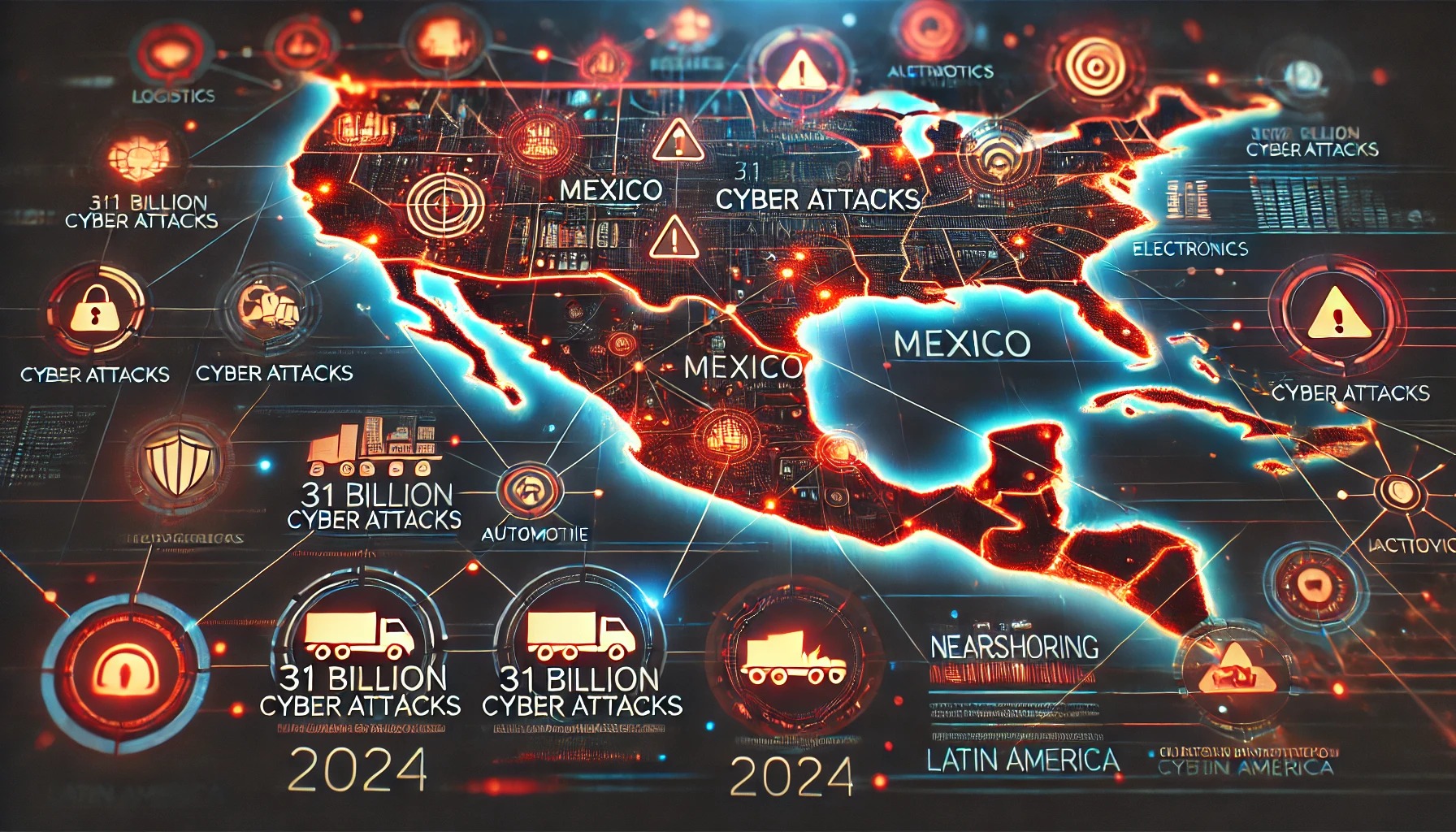In the first half of 2024, Mexico accounted for over 50% of all cyber threats in Latin America, according to a recent study by cybersecurity giant Fortinet. As Mexico experiences rapid growth in nearshoring—a trend where companies shift production closer to key markets—the country has become a prime target for cybercriminals. Key sectors such as logistics, automotive, and electronics manufacturing are increasingly vulnerable, making cybersecurity a top priority for businesses in the region.
Why Cybersecurity is Critical for Mexico:
The rise in cyberattacks is linked directly to Mexico's expanding role in nearshoring, where multinational companies are setting up production closer to their primary consumer bases, especially the U.S. This economic shift has made industries like logistics, automotive, and electronics more attractive to cybercriminals. Hackers are targeting these sectors not only for financial gain but to cause widespread disruption. The increasing use of artificial intelligence (AI) by cybercriminals is amplifying the scale and sophistication of attacks, making it crucial for companies to enhance their cybersecurity measures.
Alarming Cybercrime Statistics in Mexico
During the first half of 2024, Mexico experienced a staggering 31 billion cybercrime attempts, representing 55% of all cyber threats reported in Latin America. These figures highlight Mexico's vulnerability as cybercriminals leverage AI technology to optimize their attacks. In comparison, Mexico faced 94 billion cyberattacks throughout 2023, indicating a slight slowdown in the attack rate, but the threat level remains critically high.
Nearshoring's Role in Cybersecurity Risks:
Jorge Miranda, Fortinet’s head of operations in Mexico, emphasized that Mexico’s proximity and strong commercial ties with the United States have made it an attractive target for cybercriminals. The sectors most affected by nearshoring, such as manufacturing, are being directly hit by ransomware attacks, often resulting in demands for much higher ransoms. This is a growing concern for businesses, as the damage from such attacks can disrupt entire supply chains.
AI Shortage Compounding Cybersecurity Challenges:
In addition to the rise in cyber threats, the report also sheds light on the shortage of AI professionals, which is exacerbating cybersecurity challenges. Fortinet estimates that there is a global shortage of 4 million AI experts, with Latin America and the Caribbean accounting for 1.3 million of that gap, and Mexico specifically short by around 500,000. This shortage is limiting the country’s ability to respond effectively to the growing wave of AI-driven cyberattacks.
Future of Cybersecurity in Mexico:
Fortinet is optimistic that Mexico will take significant steps to bolster its cybersecurity defenses in the coming years. One key development on the horizon is the potential enactment of a national cybersecurity law, which could offer much-needed protection to businesses and critical infrastructure. In line with this, President Claudia Sheinbaum has pledged to establish a cybersecurity and artificial intelligence center during her term. However, details about a formal cybersecurity law remain unclear.
Conclusion
As cyber threats continue to escalate in Mexico due to the nearshoring boom and advancements in AI technology, businesses must prioritize cybersecurity measures. With Mexico leading Latin America in cyberattacks, organizations must adopt robust defense strategies to protect their operations from evolving threats. Fortinet’s report serves as a wake-up call, underscoring the urgent need for both legislative action and investment in cybersecurity talent to safeguard Mexico's digital future.



 South Korea Warns Weak Won Could Push Inflation Higher in 2025
South Korea Warns Weak Won Could Push Inflation Higher in 2025  Asian Markets Rebound as Tech Rally Lifts Wall Street, Investors Brace for BOJ Rate Hike
Asian Markets Rebound as Tech Rally Lifts Wall Street, Investors Brace for BOJ Rate Hike  Oil Prices Climb on Venezuela Blockade, Russia Sanctions Fears, and Supply Risks
Oil Prices Climb on Venezuela Blockade, Russia Sanctions Fears, and Supply Risks  Yen Near Lows as Markets Await Bank of Japan Rate Decision, Euro Slips After ECB Signals Caution
Yen Near Lows as Markets Await Bank of Japan Rate Decision, Euro Slips After ECB Signals Caution  Trump Orders Blockade of Sanctioned Oil Tankers, Raising Venezuela Tensions and Oil Prices
Trump Orders Blockade of Sanctioned Oil Tankers, Raising Venezuela Tensions and Oil Prices  Asian Stocks Edge Higher as Tech Recovers, U.S. Economic Uncertainty Caps Gains
Asian Stocks Edge Higher as Tech Recovers, U.S. Economic Uncertainty Caps Gains  Dollar Holds Firm Ahead of Global Central Bank Decisions as Yen, Sterling and Euro React
Dollar Holds Firm Ahead of Global Central Bank Decisions as Yen, Sterling and Euro React  New Zealand Business Confidence Hits 30-Year High as Economic Outlook Improves
New Zealand Business Confidence Hits 30-Year High as Economic Outlook Improves  U.S. Stock Futures Slip After CPI-Fueled Rally as Markets Weigh Economic Uncertainty
U.S. Stock Futures Slip After CPI-Fueled Rally as Markets Weigh Economic Uncertainty  Japan Inflation Holds Firm in November as BOJ Nears Key Rate Hike Decision
Japan Inflation Holds Firm in November as BOJ Nears Key Rate Hike Decision  Japan Exports to U.S. Rebound in November as Tariff Impact Eases, Boosting BOJ Rate Hike Expectations
Japan Exports to U.S. Rebound in November as Tariff Impact Eases, Boosting BOJ Rate Hike Expectations  Asian Fund Managers Turn More Optimistic on Growth but Curb Equity Return Expectations: BofA Survey
Asian Fund Managers Turn More Optimistic on Growth but Curb Equity Return Expectations: BofA Survey  Asian Stocks Slide as AI Spending Fears and Global Central Bank Decisions Weigh on Markets
Asian Stocks Slide as AI Spending Fears and Global Central Bank Decisions Weigh on Markets  BoE Set to Cut Rates as UK Inflation Slows, but Further Easing Likely Limited
BoE Set to Cut Rates as UK Inflation Slows, but Further Easing Likely Limited  EU Delays Mercosur Free Trade Agreement Signing Amid Ukraine War Funding Talks
EU Delays Mercosur Free Trade Agreement Signing Amid Ukraine War Funding Talks  Silver Prices Hit Record High as Safe-Haven Demand Surges Amid U.S. Economic Uncertainty
Silver Prices Hit Record High as Safe-Haven Demand Surges Amid U.S. Economic Uncertainty  Austan Goolsbee Signals Potential for More Fed Rate Cuts as Inflation Shows Improvement
Austan Goolsbee Signals Potential for More Fed Rate Cuts as Inflation Shows Improvement 































